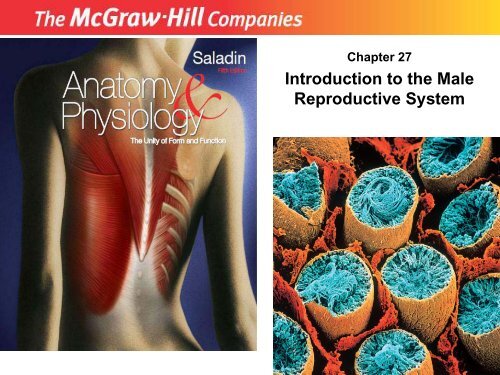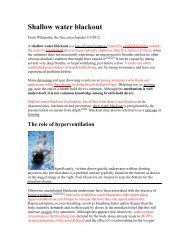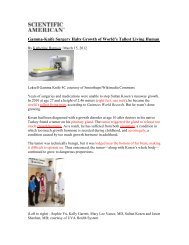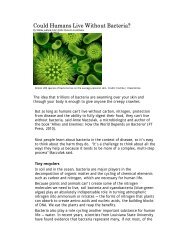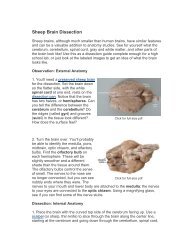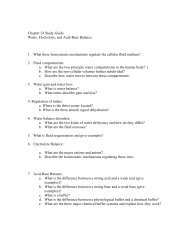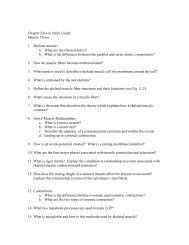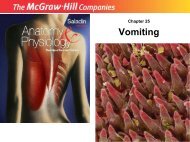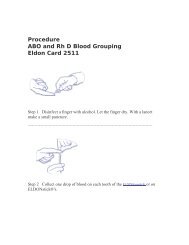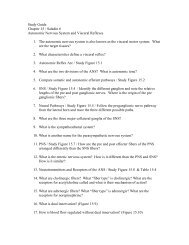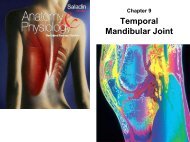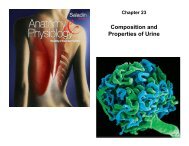Introduction to the Male Reproductive System
Introduction to the Male Reproductive System
Introduction to the Male Reproductive System
- No tags were found...
Create successful ePaper yourself
Turn your PDF publications into a flip-book with our unique Google optimized e-Paper software.
Chapter 27<br />
<strong>Introduction</strong> <strong>to</strong> <strong>the</strong> <strong>Male</strong><br />
<strong>Reproductive</strong> <strong>System</strong>
The Two Sexes<br />
• essence of sexual reproduction is that it is<br />
biparental<br />
– offspring receive genes from two parents<br />
– offspring not genetically identical <strong>to</strong> ei<strong>the</strong>r one<br />
– we will die, but our genes will live on in a<br />
different container, our offspring<br />
• gametes (sex cells) produced by each<br />
parent<br />
– Female produce <strong>the</strong> egg<br />
– <strong>Male</strong> produce <strong>the</strong> sperm<br />
• zygote (fertilized egg) has combination of<br />
both parent’s genes
Two Sexes<br />
• male and female gametes (sex cells) combine <strong>the</strong>ir<br />
genes <strong>to</strong> form a zygote (fertilized egg )<br />
– one gamete has motility = sperm (sperma<strong>to</strong>zoon)<br />
• parent producing sperm considered male<br />
• parent with a Y chromosome is male<br />
– o<strong>the</strong>r gamete, egg or (ovum) contains nutrients for<br />
developing embryo<br />
• parent producing eggs considered female<br />
• anyone lacking a Y chromosome is female<br />
• in mammals, female is <strong>the</strong> parent that provides a sheltered<br />
internal environment and prenatal nutrition of <strong>the</strong><br />
embryo<br />
– males have a copula<strong>to</strong>ry organ (penis) for introducing<br />
his gametes in<strong>to</strong> <strong>the</strong> female reproductive tract<br />
– females have a copula<strong>to</strong>ry organ (vagina) for receiving<br />
<strong>the</strong> sperm
Overview of <strong>Reproductive</strong> <strong>System</strong><br />
• male reproductive system serves <strong>to</strong> produce sperm and<br />
introduce <strong>the</strong>m in<strong>to</strong> <strong>the</strong> female body<br />
• female reproductive system produces eggs, receives<br />
sperm, provides for <strong>the</strong> union of <strong>the</strong> gametes, harbors <strong>the</strong><br />
fetus, and nourishes <strong>the</strong> offspring<br />
• reproductive system consists of primary and secondary<br />
sex organs<br />
– primary sex organs (gonads)<br />
• produce gametes (testes or ovaries)<br />
– secondary sex organs<br />
• organs o<strong>the</strong>r than <strong>the</strong> gonads that are necessary for reproduction<br />
– male – system of ducts, glands, penis deliver sperm cells<br />
– female - uterine tubes, uterus, and vagina receive sperm and<br />
harbor developing fetus
Overview of <strong>Reproductive</strong> <strong>System</strong><br />
• external genitalia – located in <strong>the</strong> perineum<br />
– most are externally visible<br />
– except accessory glands of <strong>the</strong> female perineum<br />
• internal genitalia – located mainly in <strong>the</strong> pelvic cavity<br />
– except for testes and some associated ducts in <strong>the</strong> scrotum<br />
• secondary sex characteristics<br />
– features that fur<strong>the</strong>r distinguish <strong>the</strong> sexes and play a role in<br />
mate attraction<br />
– develop at puberty <strong>to</strong> attract a mate<br />
– both sexes<br />
• pubic and axillary hair and <strong>the</strong>ir associated scent glands, and<br />
<strong>the</strong> pitch of <strong>the</strong> voice<br />
– male<br />
• facial hair, coarse and visible hair on <strong>the</strong> <strong>to</strong>rso and limbs,<br />
relatively muscular physique<br />
– female<br />
• distribution of body fat, breast enlargement, and relatively<br />
hairless appearance of <strong>the</strong> skin
Chromosomal Sex Determination<br />
• human cells contain 23 pairs of<br />
chromosomes (<strong>to</strong>tal of 46!)<br />
X<br />
X<br />
XX = female<br />
– 22 pairs of au<strong>to</strong>somes<br />
Sperm<br />
Egg<br />
– 1 pair of sex chromosomes<br />
• (XY males: XX females)<br />
• males produce half Y carrying<br />
sperm and half X carrying sperm<br />
• all eggs carry <strong>the</strong> X chromosome<br />
Y<br />
X<br />
XY = male<br />
sex of child determined by type of sperm that fertilizes mo<strong>the</strong>r’s egg<br />
• X-carrying sperm fertilizes <strong>the</strong> egg – female<br />
• Y-carrying sperm fertilizes <strong>the</strong> egg - male
Prenatal Hormones and Sex Differentiation<br />
• initially, a fetus is sexually undifferentiated as <strong>to</strong> which sex<br />
it will become<br />
• gonads begin <strong>to</strong> develop at 5 or 6 weeks as gonadal ridges<br />
• two sets of ducts adjacent <strong>to</strong> each gonadal ridge<br />
– mesonephric ducts develop in<strong>to</strong> male reproductive system<br />
• paramesonephric ducts degenerate<br />
– paramesonephric ducts (müllerian ducts) develop in<strong>to</strong><br />
female reproductive tract<br />
• mesonephric ducts degenerate<br />
• SRY gene (sex-determining region of Y chromosome)<br />
– in males, codes for a protein, testes-determining fac<strong>to</strong>r (TDF),<br />
that initiates development of testes<br />
• begin <strong>to</strong> secrete tes<strong>to</strong>sterone 8 <strong>to</strong> 9 weeks<br />
• stimulates mesonephric ducts <strong>to</strong> develop in<strong>to</strong> <strong>the</strong> male ana<strong>to</strong>my<br />
• at same time <strong>the</strong> testes secrete müllerian-inhibiting fac<strong>to</strong>r causing<br />
degeneration of <strong>the</strong> paramesonephric ducts<br />
• estrogen levels are always high in pregnancy<br />
– if estrogen was <strong>the</strong> hormone that directed <strong>the</strong> female development, all<br />
fetuses would be feminized<br />
• female development occurs in absence of androgen<br />
hormones
Copyright © The McGraw-Hill Companies, Inc. Permission required for reproduction or display.<br />
Development<br />
of <strong>Reproductive</strong><br />
Tracts<br />
Mesonephros<br />
Gonadal ridge<br />
Kidney<br />
<strong>Male</strong><br />
5- <strong>to</strong> 6-week embryo;<br />
sexually indifferent stage<br />
Mesonephric duct<br />
Paramesonephric<br />
(müllerian) duct<br />
Cloaca<br />
Female<br />
Testes<br />
Efferent ductules<br />
Epididymis<br />
Paramesonephric<br />
duct (degenerating)<br />
Mesonephric duct<br />
forming <strong>the</strong><br />
ductus deferens<br />
Urinary bladder<br />
Seminal vesicle<br />
Urogenital sinus<br />
forming <strong>the</strong> urethra<br />
7 <strong>to</strong> 8 weeks<br />
Ovaries<br />
Paramesonephric<br />
duct forming <strong>the</strong><br />
uterine tube<br />
Mesonephric duct<br />
(degenerating)<br />
Fused paramesonephric<br />
ducts forming<br />
<strong>the</strong> uterus<br />
Urinary bladder<br />
(moved aside)<br />
Urogenital sinus<br />
forming <strong>the</strong> urethra<br />
and lower vagina<br />
8 <strong>to</strong> 9 weeks<br />
Urinary<br />
bladder<br />
Seminal<br />
vesicle<br />
Prostate gland<br />
Bulbourethral<br />
gland<br />
Ductus deferens<br />
Epididymis<br />
Uterine<br />
tube<br />
Ovary<br />
Uterus<br />
Urinary bladder<br />
(moved aside)<br />
Vagina<br />
Testis<br />
Urethra<br />
Urethra<br />
Hymen<br />
Penis<br />
Vestibule<br />
At birth<br />
At birth
Development of External Genitalia<br />
• male and female organs that develop from <strong>the</strong><br />
same embryonic structure are homologous<br />
– penis is homologous <strong>to</strong> <strong>the</strong> cli<strong>to</strong>ris<br />
– scrotum is homologous <strong>to</strong> <strong>the</strong> labia majora<br />
• similarity of external genitalia of both sexes<br />
– genital tubercle becomes <strong>the</strong> head (glans) of <strong>the</strong> penis<br />
or glans cli<strong>to</strong>ris<br />
– pair of urogenital folds encloses urethra of male forming<br />
<strong>the</strong> penis or forms <strong>the</strong> labia minora<br />
– pair of labioscrotal folds becomes ei<strong>the</strong>r scrotum or<br />
labia majora<br />
• by week 12, ei<strong>the</strong>r male or female genitalia are<br />
distinctly formed
Development<br />
of External<br />
Genitalia<br />
Copyright © The McGraw-Hill Companies, Inc. Permission required for reproduction or display.<br />
Genital tubercle<br />
Urogenital fold<br />
Labioscrotal fold<br />
Tail<br />
6 weeks<br />
8 weeks<br />
<strong>Male</strong><br />
Female<br />
Phallus:<br />
Developing glans<br />
of penis<br />
Urethral groove<br />
Developing glans<br />
of cli<strong>to</strong>ris<br />
Labia minora<br />
Urethral groove<br />
Labia majora<br />
Anus<br />
Anus<br />
10 weeks 10 weeks<br />
Urethral orifice<br />
Glans of penis<br />
Prepuce<br />
Prepuce<br />
Glans of cli<strong>to</strong>ris<br />
Urethral orifice<br />
Scrotum<br />
Vaginal orifice<br />
Perineal raphe<br />
Anus<br />
Perineal raphe<br />
Anus<br />
12 weeks 12 weeks
Descent of Testes<br />
• both male and female gonads initially develop high in<br />
<strong>the</strong> abdominal cavity near <strong>the</strong> kidneys<br />
• migrate in<strong>to</strong> <strong>the</strong> pelvic cavity (ovaries) or scrotum<br />
(testes)<br />
• gubernaculum – a connective tissue cord extends from<br />
<strong>the</strong> gonad <strong>to</strong> <strong>the</strong> floor of <strong>the</strong> pelvic cavity<br />
– in <strong>the</strong> male, passes between <strong>the</strong> internal and external<br />
abdominal oblique muscles in<strong>to</strong> <strong>the</strong> scrotal swelling<br />
– vaginal process – fold of <strong>the</strong> peri<strong>to</strong>neum that extends in<strong>to</strong><br />
<strong>the</strong> scrotum<br />
– inguinal canal – pathway of low resistance through <strong>the</strong><br />
groin created by gubernaculum and vaginal process<br />
• most common site of herniation in boys and men – inguinal<br />
hernia
Descent of Testes<br />
• descent of <strong>the</strong> testes begins as early as 6 weeks<br />
– in 7 th month testes abruptly pass through <strong>the</strong> inguinal<br />
canal in<strong>to</strong> <strong>the</strong> scrotum guided by <strong>the</strong> gubernaculum<br />
– testes accompanied by elongating testicular arteries and<br />
veins, lymphatic vessels, nerves, spermatic ducts, and<br />
extensions of internal abdominal oblique muscle<br />
• cryp<strong>to</strong>rchidism – boys born with undescended testes<br />
– occurs in about 3% of male births<br />
– most cases <strong>the</strong> testes descend during <strong>the</strong> first year of<br />
infancy<br />
– if not, tes<strong>to</strong>sterone injection or simple surgery <strong>to</strong> draw<br />
testes in<strong>to</strong> <strong>the</strong> scrotum<br />
– uncorrected cases lead <strong>to</strong> sterility or testicular cancer<br />
• ovaries descend <strong>to</strong> lesser extent<br />
– lodge on inferior brim of <strong>the</strong> lesser pelvis<br />
– gubernaculum becomes a pair of ligaments that supports<br />
<strong>the</strong> ovary and <strong>the</strong> uterus
Descent of Testis<br />
Copyright © The McGraw-Hill Companies, Inc. Permission required for reproduction or display.<br />
3-month fetus 8-month fetus 1-month-old infant<br />
Parietal<br />
peri<strong>to</strong>neum<br />
Epididymis<br />
Testis<br />
Ductus deferens<br />
Pubic symphysis<br />
Vaginal process<br />
Gubernaculum<br />
Scrotal swelling<br />
Muscular wall<br />
of abdomen<br />
Inguinal canal<br />
Vaginal process<br />
Penis<br />
Closed proximal<br />
portion of<br />
vaginal process<br />
Spermatic cord<br />
Tunica vaginalis<br />
Scrotum<br />
Gubernaculum
Androgen-Insensitivity Syndrome<br />
• occasionally, a girl shows all <strong>the</strong> usual<br />
changes of puberty, but fail <strong>to</strong> menstruate<br />
– presence of testes in <strong>the</strong> abdomen<br />
– karyotype of XY chromosomes of<br />
a male<br />
– testes produce normal male levels<br />
of tes<strong>to</strong>sterone<br />
– target cells lack recep<strong>to</strong>rs for it<br />
– external genitalia develop female<br />
ana<strong>to</strong>my as if no tes<strong>to</strong>sterone<br />
were present<br />
– no uterus or menstruation<br />
Courtesy Mihaly Bartalos, from M. Bartalos and T.A. Baramki, 1967 Medical<br />
Cy<strong>to</strong>genetics, Williams & Wilkins


